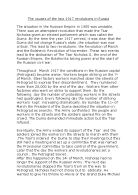In July 1914 Russia entered the First World War on the side of Britain and France, fighting Germany and Austro-Hungaria. At first the conflict helped the Tsar. The natural rallying together of all the classes occurred, and the Tsar was looked towards for leadership that was needed in the conflict. But after the first defeat at Tannenburg, the initial nationalistic enthusiasm was lost, and the Tsar was to make some fatal mistakes that lost much support of the Russian people.
In August 1915 the Tsar left St Petersburg to command the Russian army, and this meant the people held him to blame for the subsequent defeats it suffered. The army was made up of poor, starving peasants with bad equipment, few supplies and little training. When in 1916 two million soldiers were killed or wounded, and one third of a million taken prisoner, the civilian population was horrified. The Tsar was considered to be irresponsible as a leader and he was blamed for the disastrous outcome. In Russia at the time the Tsarina and Rasputin were left in charge, and further worsened the situation. People distrusted both of them, some thought the Tsarina was ruling Russia deliberately ineffectively to let Germany win (she was German of birth), and rumours circulated that her and Rasputin were lovers. Furthermore, they dismissed able ministers, replacing them with hopeless ones, and leaving Russia on the verge of breaking point.
Soldiers fighting in the war saw how futile the slaughter was, and became unwilling to give their lives so readily. They were starving on the front line and got angry at how the Tsar failed to address the important problems. Factories in Russia were desperate for workers as so many men were being recruited, and wages got lower and lower so the factory owners could afford to employ the men. In December 1916 workers in St Petersburg starved due to the lack of food, that was caused by the loss of so many of the workforce. Russia faced crisis and massive discontent on all peoples’ parts. In January 1917 Russian armies were driven out of Poland and Romania. The Duma again pleaded the Tsar for the appointment of a new ministry, in a last ditch attempt to save Russia. The Tsar ignored this however, and promptly dissolved the Duma on the 11th of March, precipitating strikes by the workers. On March 7th 1917, a food riot had broken out and 40,000 workers went on strike for higher wages in St Petersburg. In the extreme hunger, women unusually joined the strikes. In St Petersburg the Tsarist system lost control all together. Because of the negative impact of the war, the army were completely sided with the protestors, and soldiers joined them in the crowds. Militants of the ‘Pavlovsky Life Guards’ shot one of their own officers and on the 12th of March regiments deserted in favour of the mutiny. The generals refused to organise resistance to the protests, and left the Tsar defenceless after the Duma encouraged them to do so. After the soldiers there was no force to keep order in St Petersburg, and without this order the Tsar could not rule, since the imperial state needed force to operate. With these events considered, the Tsar accepted defeat and resigned from office on the afternoon of 12th March 1917.
The Duma formed a provisional government in the turmoil, headed by twelve representatives. It held little political strength or authority however, with ministers that had not been voted in and no Tsar to head it. The committee also promised a ‘Constituent Assembly’ that would restore peace and order in Russia, but which had not been planned and would not have been established for some time. With the fall of the Tsar, the ‘Petrograd Soviet’ reformed in St Petersburg, in the style of the earlier 1905 Soviet. It represented the general opinions and demands of the workers and soldiers; as well as the Bolsheviks, Mensheviks and Socialist Revolutionaries.
Being at first disorganised, the Soviet cooperated with the Provisional Government to a certain degree, but had its sights set on becoming the primary authority in Russia. With to parties holding power in Russia, and representing two different social groups in the country, the ‘dual-power’ seems as though it were doomed to failure. With this inherent instability Russia could not be ensured of an effective political future, or indeed peace, while two rival parties attempted to gain more power and support than the other. The Grand Duke Michael refused the throne and left Russia with only two possible ruling bodies, one of the bourgeois middle class and one of revolutionary orientations.
After pressure from the Petrograd Soviet, the Provisional government did bring in immediate reforms to basic civil liberties, and this move did help to slightly strengthen support for the government; with freedom of speech and press, as well as an amnesty for political prisoners. The Soviet immediately struck back with the publishing of Izvestiya, its political paper. A certain degree of anarchy resulted from the publishing of the paper, since it contained articles that urged peasants to confiscate land off their landlords. In fact, the reforms ultimately helped the decline of the Provisional government, as the amnesty encouraged some important revolutionaries such as Stalin and Trotsky to return from their exile on hearing about the revolution. Order No.1, posted by the Soviet, effectively put the armed forces under Soviet supervision and removed all influence that the Provisional Government had over the military force; meaning that politically the Soviets had a major advantage over the government. The army had natural swaying towards the Soviet cause after it had witnessed the first revolution and the failure of the Tsar and accepted Order #1, with this significant further backing the Soviets were starting to seriously threaten the government’s position.
The Provisional government was increasingly being viewed, by the majority of the Russian population, as the tool of the middle-class to delay the inevitable victory of socialism in Russia. The Petrograd Soviet gained support as it went, whereas the government was losing it at a quick rate. The First World War split the two parties further, with Soviets demanding peace and the government insisting that a continuing war effort would be the most fruitful option, with both ethical and economical reasons for its stance. Some revolutionaries saw ‘defensism’ as a way of strengthening the Soviet’s position, by cooperating with the government.
When Lenin returned to Russia in April 1917 he gave a strong argument against the Provisional Government with his ‘April Thesis’, and encouraged the idea of Bolshevik separatism from the government, and started a campaign for the Bolsheviks to take over the Soviet. Lenin addressed the wishes of the people and got their support in return for his radical stance. His powerful messages such as ‘defeatism’ (immediate withdrawal from the war) were very appealing to a people that stood confused in a country with so many changing policies, and this marked the surge of support for Bolshevism in Russia. With the secret police disbanded, and no armed force to turn to for support, the government had to rule as ‘government by committee’, relying on compromises that hardly exercised any power whatsoever. ‘The people’ played a large part in the rise of Lenin’s Bolsheviks, with further riots and strikes that wore down the government. Evidence for this was the inclusion of Alex Kerensky and other socialists in the government after the War minister (Alex Guchkov) resigned under the increasing pressure from the Soviet. The disastrous failure of the Russian Galician offensive prompted Kerensky to try desperately hard to focus the army on victory, but Bolshevik propaganda and Order #1 turned the army against Kerensky himself by giving him the image of a war mongerer, and the army mutinied in face of the Russian defeat. Now the Bolsheviks had a real chance to overthrow the government, especially in St Petersburg with an excess of discontent workers and soldiers, but loyal government troops arrived from the front lines to quell the rising and it lost its momentum. There was a crackdown on the Bolsheviks by the government in July 1917, which resulted in a slight lull in support for the party and the arrest of Trotsky, but not nearly enough disruption to causes the abandonment of the whole movement. In fact the government, and ministers such as Tsereteli and Kerensky, underestimated the threat posed by the Bolsheviks, and took limited action to suppress Bolshevik support. The conflict of government ministers Kerensky and Kornilov over the issue of the power held by the Petrograd Soviet led to a leadership crisis when the Germans were launching offensives on Russian territory. Kornilov, the radical right-wing minister, ordered an advance on St Petersburg in an attempt to overthrow the Soviet. When Kerensky turned to the Bolsheviks for support, he released and rearmed Bolshevik supporters to protect St Petersburg. This move allowed the Bolshevik party to re-form and recover from the damage done to its reputation in July.
Kerensky’s erratic action had weakened his position, and Lenin’s treatise that he wrote in Finland while in exile and sent back to Russia consisted of instructions for Bolshevik action against the government while it was vulnerable. This reassured Bolsheviks that they should be continuing their struggle against the government, and helped to prompt a surge in the Bolsheviks’ campaign for control of Russia.
A series of events proved the plight of the Provisional Government, and removed its last significant support among the people. The worsening situations on the front lines and in Russia itself were the primary sources of the governments’ failures. On the Eastern Front mutinies were occurring on quite a large scale due to both the defeat of the army, and lack of provisions for the soldiers, the blame for which, was landed solely on the Provisional Government. The failures on the battlefield caused mass inflation in Russia, and since all soldiers were fighting, there was no force to keep order. And so in Russia public disorder prevailed in towns and cities as well as peasant risings against landlords. These were directly connected to the lack of authority on the government’s part and all of the blame came to rest upon the ineptitude of the government. Fuel and food shortages were also widespread because of the lack of workers, who were on strike. The Bolsheviks turned the crisis into pro-Bolshevik propaganda, offering order and solutions to the common problems (for example the peace, bread, land slogan). In fact, the rising support for Bolshevism was mostly fuelled purely by the common dislike for the Provisional Government and its policies. The government had made an irreversible mistake by delaying the policies and efforts that would have bettered the agricultural and industrial problems. The ‘Land-committee’ which had set out to do the job of organising the economical policies was a disorganised and inexperienced group of enthusiastic revolutionaries which ended up doing more harm than good, in proving the Provisional Government incapable, in the extreme, of handling even one of the vital issues surrounding Russia at the time.
The Bolsheviks, in fact, saw the inherent weaknesses in the Petrograd Soviet, and realised that it would make an ideal tool for the purpose of seizing power, and simultaneously defeating all of their opposition in the Soviet. The support for the Bolsheviks was proved when in September 1917 they won a majority in the Petrograd and Moscow Soviets, and it was not far to go until the party had full control of Russia.
Elections were going to be held on 25th of November for the predicted constituent Assembly, announced by Kerensky. On hearing of these Lenin returned to Russia and arranged for the Bolshevik delegates to walk out of the pre-parliamentary meeting, which would prepare for the seizure of power. At this point the other delegates underestimated the scale of the Bolshevik threat, and the decision to avoid a pre-emptive armed uprising allowed the Bolsheviks to continue with their plans for taking power. The Bolsheviks timed their attack on the government perfectly, when it was in the most turmoil and when the government was in the middle of the change over process from the provisional to full time government. Before this point the government was too stable to have fallen to the Bolsheviks, and after the change over it would have had a solidarity to it that would also have made a coup far more challenging. The unsympathetic mood of the soldiers towards Kerensky was another factor that failed to stop the Bolsheviks from moving towards their coup, and this was unfortunate for him since at this stage the Bolsheviks could have been suppressed with only minimal force and manpower. Alex Verkhovsky’s attempts to remove much of the Bolshevik support were themselves undermined by Kerensky’s dismissal of this latest War Minister. This allowed Trotsky to form a revolutionary militant force, the Red Guard, and organise the Military revolutionary Committee, which had itself been established through the Petrograd Soviet. With all preparations in place, the committee occupied vantage points in St Petersburg like the railway and official buildings on 6-7th of November, while acting under orders of the Bolsheviks. The government palace where Kerensky and his ministers worked was besieged, and a shot fired over the palace from the ship Aurora. The palace was stormed easily (since only cadets were guarding it) and the ministers arrested, signalling the end for the Provisional Government. That evening Lenin appeared in public to make a speech declaring that Russia belonged to the Soviets and the deputies of the workers, soldiers and peasants. In all large towns and cities in Russia power was soon in the hands of the soviets.
The Bolsheviks had reached their success through the manipulation of both the unrest created by the Tsars abdication and the failure of the Provincial Government to establish power effectively. The first revolution should have been the last, and would have been had both the chance events, and initiative on the part of the Bolshevik party and leaders not led to a coup and second revolution in Russia. Failings of governments and policies, the impact of the First World War and chaos in Russia in 1917 led to one of the most complex and erratic revolutions in history.






